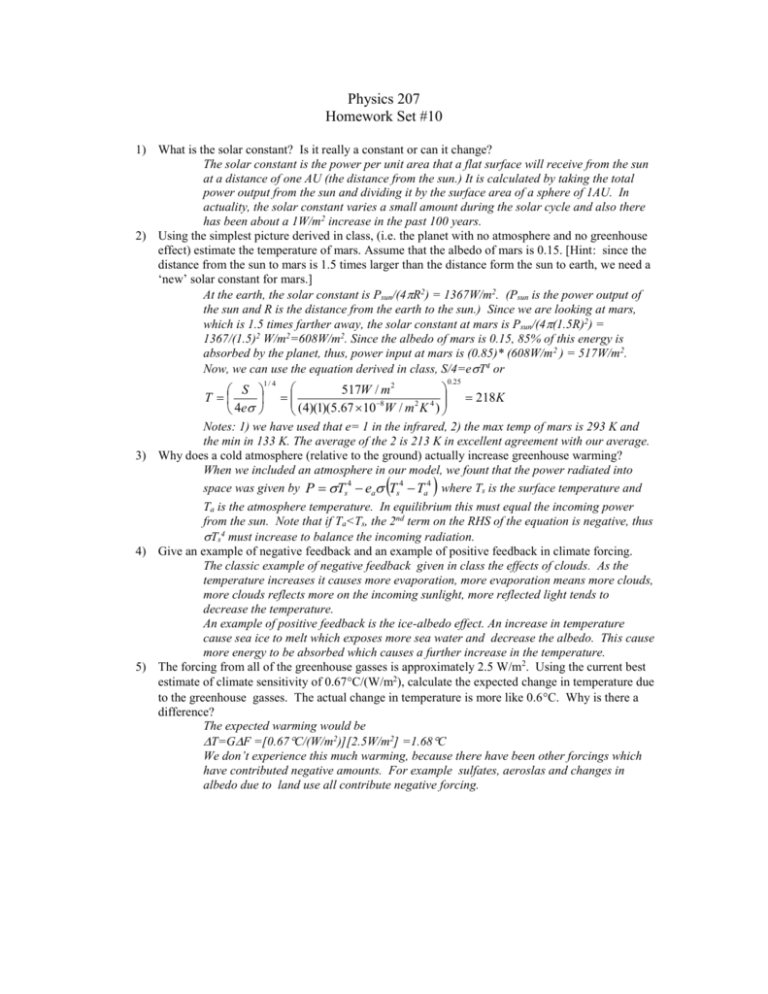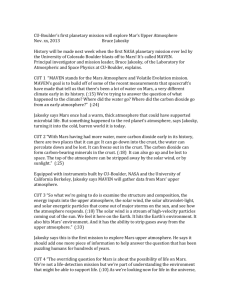Physics 207
advertisement

Physics 207 Homework Set #10 1) What is the solar constant? Is it really a constant or can it change? The solar constant is the power per unit area that a flat surface will receive from the sun at a distance of one AU (the distance from the sun.) It is calculated by taking the total power output from the sun and dividing it by the surface area of a sphere of 1AU. In actuality, the solar constant varies a small amount during the solar cycle and also there has been about a 1W/m2 increase in the past 100 years. 2) Using the simplest picture derived in class, (i.e. the planet with no atmosphere and no greenhouse effect) estimate the temperature of mars. Assume that the albedo of mars is 0.15. [Hint: since the distance from the sun to mars is 1.5 times larger than the distance form the sun to earth, we need a ‘new’ solar constant for mars.] At the earth, the solar constant is Psun/(4R2) = 1367W/m2. (Psun is the power output of the sun and R is the distance from the earth to the sun.) Since we are looking at mars, which is 1.5 times farther away, the solar constant at mars is Psun/(4(1.5R)2) = 1367/(1.5)2 W/m2=608W/m2. Since the albedo of mars is 0.15, 85% of this energy is absorbed by the planet, thus, power input at mars is (0.85)* (608W/m 2 ) = 517W/m2. Now, we can use the equation derived in class, S/4=eT4 or 0.25 517W / m 2 S 218K T 8 2 4 4e (4)(1)(5.67 10 W / m K ) Notes: 1) we have used that e= 1 in the infrared, 2) the max temp of mars is 293 K and the min in 133 K. The average of the 2 is 213 K in excellent agreement with our average. 3) Why does a cold atmosphere (relative to the ground) actually increase greenhouse warming? When we included an atmosphere in our model, we fount that the power radiated into space was given by P Ts4 ea Ts4 Ta4 where Ts is the surface temperature and Ta is the atmosphere temperature. In equilibrium this must equal the incoming power from the sun. Note that if Ta<Ts, the 2nd term on the RHS of the equation is negative, thus Ts4 must increase to balance the incoming radiation. 4) Give an example of negative feedback and an example of positive feedback in climate forcing. The classic example of negative feedback given in class the effects of clouds. As the temperature increases it causes more evaporation, more evaporation means more clouds, more clouds reflects more on the incoming sunlight, more reflected light tends to decrease the temperature. An example of positive feedback is the ice-albedo effect. An increase in temperature cause sea ice to melt which exposes more sea water and decrease the albedo. This cause more energy to be absorbed which causes a further increase in the temperature. 5) The forcing from all of the greenhouse gasses is approximately 2.5 W/m2. Using the current best estimate of climate sensitivity of 0.67C/(W/m2), calculate the expected change in temperature due to the greenhouse gasses. The actual change in temperature is more like 0.6C. Why is there a difference? The expected warming would be T=GF =[0.67C/(W/m2)][2.5W/m2] =1.68C We don’t experience this much warming, because there have been other forcings which have contributed negative amounts. For example sulfates, aeroslas and changes in albedo due to land use all contribute negative forcing. 1/ 4











